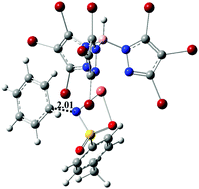Computational exploration of the mechanism of copper-catalyzed aromatic C–H bond amination of benzene via a nitrene insertion approach†
Abstract
The mechanism of aromatic C–H amination of benzene via a nitrene insertion approach catalyzed by the TpBr3Cu(NCMe) complex was computationally investigated. The results of computational studies show that addition of the nitrene moiety of the TpBr3Cu–nitrene intermediate to benzene, and therefore, to form an aziridine intermediate, is more favorable than the nitrene moiety induced hydrogen atom abstraction from a sp2 C–H bond of benzene. Subsequently, the cleavage of a C–N bond of the aziridine intermediate followed by an H-atom transfer step might occur, due to the driving force of the rearomatization, to afford the desired aromatic C–H amination product. For toluene, computational results suggest that the benzylic C–H amination via hydrogen atom abstraction followed by radical rebound path is more favorable than the aromatic C–H amination via a nitrene addition path, which is in accord with experimental results.


 Please wait while we load your content...
Please wait while we load your content...